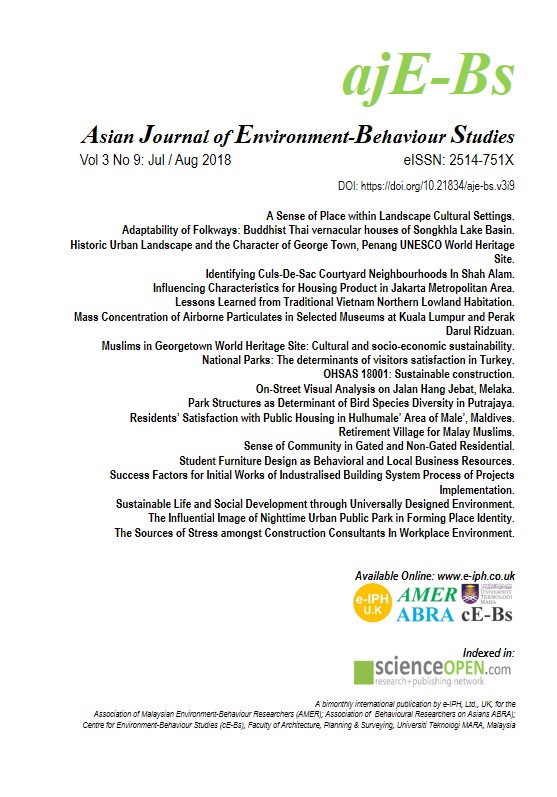Sense of Community in Gated and Non-Gated Residential
Main Article Content
Abstract
Neighbourhood design is one of the factors contributing towards the establishment and maintenance of local community ties. The differences in environmental size and design of neighbourhoods are perceived to influence sense of community networking functions. A physical element such as gated element is also believed to have an influence on local community relationship networking. Therefore, a study on sense of community was conducted in two neighbourhood areas: Putrajaya (non-gated) and Bandar Baru Bangi (gated) using face to face interview method. This study found that residents of non-gated residential areas demonstrated higher sense of community (M=6.47 SP=0.08) than residents of gated residential areas (M=6.39, SP=1.08).
Article Details
License
Copyright (c) 2018 Siti Rasidah Md Sakip, Noraini Johari, Mohd Najib Mohd Salleh

This work is licensed under a Creative Commons Attribution-NonCommercial-NoDerivatives 4.0 International License.
References
Fachinger, J., den Exter, M., Grambow, B., Holgerson, S., Landesmann, C., Titov, M., et al. (2004). Behavior of spent HTR fuel elements in aquatic phases of repository host rock formations, 2nd International Topical Meeting on High Temperature Reactor Technology. Beijing, China, paper #B08.
Hafazah, A., K., & Siti Mareenah, A., R. (2010). Community Participation: Towards a Safer Housing Environment. Asian Journal of Environment-Behaviour Studies, 1(2), 19-31.
Heng Z., & Siu, L., L. (2013). Assessing the renovation of existing residential buildings regarding environmental efficiency. Asian Journal of Environment-Behaviour Studies, 4(14), 19-35
Mehdi K., & Koorosh, A. (2015). Achievement to Environmental Components of Educational Spaces for Iranian Trainable Children with Intellectual Disability. Procedia - Social and Behavioral Sciences, 201, 9-18.
Mettam, G. R., & Adams, L. B. (1999). How to prepare an electronic version of your article. In B. S. Jones & R. Z. Smith (Eds.), Introduction to the electronic age (pp. 281–304). New York: E-Publishing Inc.
Strunk, W., Jr., & White, E. B. (1979). The elements of style (3rd ed.). New York: MacMillan.
Wichitra, S., Kidanun D., & Warapon, K. (2012). Household Recycling Behaviours and Attitudes toward Waste Bank Project: Mahasarakham Municipality. Journal of ASIAN Behavioural Studies, 2(6), 35-47.

